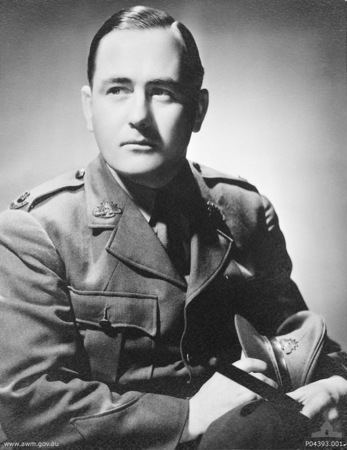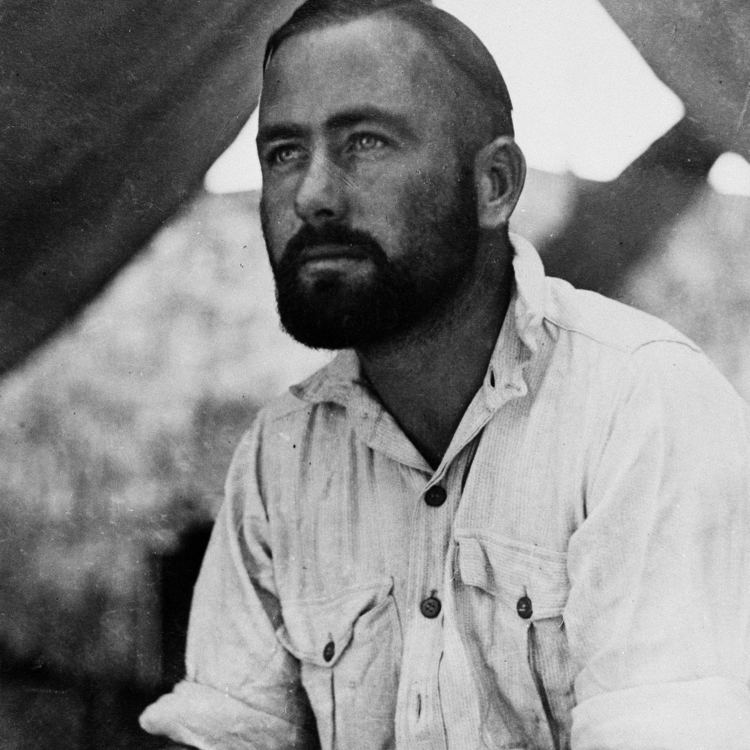Nationality Australian Occupation Anthropologist | Name William Hanley | |
 | ||
Full Name William Edward Hanley Stanner Spouse(s) Patricia Ann Williams (1962–1981) Books On aboriginal religion, The Dreaming and Other, White man got no dreaming, The South Seas in transition, People from the Dawn: Re | ||
William Edward Hanley "Bill" Stanner CMG (24 November 1905 – 8 October 1981) was an Australian anthropologist who worked extensively with Indigenous Australians. Stanner had a varied career that also included journalism in the 1930s, military service in World War II, and political advice on colonial policy in Africa and the South Pacific in the post-war period.
Contents
- Biography
- Early career
- WW2 Military service
- Career post WW2
- Referendum in 1967
- Council for Aboriginal Affairs
- Boyer Lectures in 1968
- The Great Australian Silence
- Family
- ANU Conference in 2005
- Books and publications
- Honours and tributes
- References

He was the Commanding Officer of the 2/1st North Australia Observer Unit (NAOU) during World War II, also known as the "Nackeroos" and recently coined "Curtin's Cowboys". The NAOU was the military predecessor to the modern NORFORCE. Formed in March 1942 and disbanded March 1945, they patrolled northern Australia for signs of enemy activity.
Stanner was an influential figure prior to the successful 1967 referendum on Aboriginal affairs which removed provisions in the Australian Constitution which discriminated against Indigenous Australians. In 1967, the Prime Minister Harold Holt invited Stanner to join H. C. Coombs and Barrie Dexter to form the Commonwealth Council for Aboriginal Affairs and advise on national policy. He subsequently played an important role in establishing the Australian Institute of Aboriginal and Torres Strait Islander Studies.
Stanner coined the terms the Great Australian Silence and everywhen and brought them into general usage in his 1968 Boyer Lectures After the Dreaming, which reflected on the silence on Indigenous Australians in Australian history after European settlement. Stanner profoundly changed the way Australians thought about themselves, their country and Indigenous culture.
Biography
A number of biographical references exist, the most detailed is by Diane Barwick, Jeremy Beckett and Marie Reay which was largely completed before his death in 1981.
Early career
Stanner was born at Watson's Bay, Sydney on 24 November 1905, the second son of Andrew Edwin Stanner and Mary Catherine Stanner (née Hanley). He was 3 years old when his father died. He was educated at state schools and won a bursary to Parramatta High School (1919–21), but was unable to stay on after the Intermediate Certificate for financial reasons. Stanner worked for two years in a bank and matriculated by private study. He worked as a journalist while studying at Sydney University, initially for the Cumberland Argus. In 1927 Stanner obtained full-time work as a reporter for the Sydney Daily Guardian for Frank Packer, the first of a number of posts in journalism which financed his studies in Australia and England.
At University, Stanner had an interest in athletics, football and was the secretary of the University's League of Nations Society. He stated afterward that his selection of anthropology as a profession was influenced by the famous anthropologist Alfred Radcliffe-Brown. Stanner worked as a journalist until 1932 by which time he was chief sub-edior of the Sunday Sun including several years in the Parliamentary Gallery. Stanner won the Frank Albert Prize in anthropology in two successive years and graduated with a BA (Honours) (Anthropology and Economics) in 1932.
In 1933 Stanner took up a temporary position on the personal staff of Bertram Stevens, the Premier of NSW, for whom he drafted parliamentary and public speeches and prepared reports. At that time he met H.C. Coombs and formed an enduring friendship with W.C. Wentworth with whom he worked in later life. He received an MA (Class 1 Honours) in Anthropology in 1934 from the University of Sydney for which he did extensive field research in the Daly River region of Northern Australia. A. P. Elkin judged Stanner's 1934 thesis on culture-contact at the Daly River as "a work of outstanding quality". Stanner criticised the popular assumption that the main function of the anthropologist was "the naive search for uncontaminated aboriginal cultures". He presented an exposition of a method for studying contact and cultural change, insisting that this was "an important and neglected problem". Barwick, Beckett and Reay wrote in 1985 that already his lifelong concern with the practical value of anthropology to Aboriginal welfare was apparent. Stanner lectured part-time at Sydney University and was the news editor at the World under Sydney newspaperman G. W. 'George' Warnecke.
In 1935, on his second field work, Stanner accompanied the Catholic priest Father Richard Docherty to Port Keats, now known as Wadeye on the south-western coast of the Northern Territory, halfway between the mouths of the Daly River and Fitzmaurice River. Docherty was commissioned to establish a mission in the region and Stanner helped him choose the site. Over the next thirty years, the people of the two river valleys came into the mission and eventually became permanent residents. On his appointment to the Australian National University, Stanner renewed his interest in the Port Keats Wadeye area, renewing old friendships. Much of his work as an anthropologist was based on his field work with Indigenous Australians in the Port Keats Wadeye area.
Stanner moved to London in 1936, completing his PhD at the London School of Economics in 1938 studying under Bronisław Malinowski. Compatriots included Phyllis Kaberry and Piddington. Jomo Kenyatta, the first Prime Minister (1963–1964) of Kenya and subsequently President (1964–1978) was a fellow student. Stanner's doctoral dissertation was an analysis of economic and ceremonial transactions in the Daly River communities. In London, Stanner also worked as a sub-editor in the Foreign Room at The Times.
Early academic appointments and field research included:
Under the auspices of Oxford University he did field research in Kenya in 1938–39 as part of the Oxford Expedition to Kenya and East Africa for the Oxford Social Studies Research Committee. This field research was discontinuted at the outbreak of World War II when Stanner returned to Australia. He obtained employment at the Department of Information and subsequently acted as adviser to successive Ministers for the Army, Percy Spender and Frank Forde who subsequently became Prime Minister.
WW2 Military service
In March 1942, his pre-war experience in Northern Australia led to him being directed to "raise and command" to what became the 2/1st North Australia Observer Unit (NAOU), otherwise known as 'Stanner's Bush Commandos'. At this time he enlisted in the 2nd AIF (1942–1946). Known colloquially as 'Nackeroos', the men were deployed in small groups throughout the rugged north of Australia, where they observed and reported on signs of enemy activity, often patrolling on horseback. As the unit's Commander, Major Stanner made contact with many local Aboriginal groups, and employed some to assist his troops as guides and labourers. Nackeroo operations were scaled down as the threat of Japanese invasion passed, and the unit was eventually disbanded in March 1945. The history of the unit was documented in detail by Dr. Amoury Vane.
Promoted to the rank of Lieutenant Colonel (Lt Col) in 1943, Stanner served in Europe, Britain and then in British North Borneo (Lt-Col) as Senior Civil Affairs Officer for the British Borneo Civil Affairs Unit (BBCAU) until the conclusion of the war.
Career post WW2
He continued his anthropological work after the war, becoming a prominent writer, lecturer and public advocate of the study and appreciation of Aboriginal society and its place in Australia.
Stanner's notable career postings post-World War II included:
Stanner also held a number of key leadership positions at the Australian National University including:
Referendum in 1967
Stanner was an influential figure prior to the successful 1967 referendum on Aboriginal affairs which removed provisions in the Australian Constitution which discriminated against Indigenous Australians.
Council for Aboriginal Affairs
In 1967, the Prime Minister Harold Holt invited Stanner to join H. C. Coombs and Barry Dexter to form the Council for Aboriginal Affairs and advise on national policy. Stanner held that position through successive political regimes, including the Whitlam Government, which began to implement much of the program Stanner, Coombs and Dexter endorsed: land rights, the movement to outstations, increased social welfare and community-based economies.
Stanner brought to this policy package an anthropologist's sensitivity to the importance of ceremony and ritual. In particular, at the handover of the first native title grant to the Gurindji people at Wattie Creek in the Northern Territory in 1975, Stanner recommended Prime Minister Gough Whitlam should perform the memorable symbolic act of pouring earth through the hands of Gurindji leader, Vincent Lingiari.
Boyer Lectures in 1968
In 1968 Prof W.E.H. Stanner presented the Boyer Lectures titled "After the Dreaming". The Boyer Lectures began in 1959 as the ABC (Australian Broadcasting Commission, now the Australian Broadcasting Corporation) Lectures. They were renamed in 1961 after Richard Boyer (later Sir Richard), the ABC board chairman who had first suggested the lectures. The series is broadcast every year in November/December on ABC Radio National. The lectures have been delivered annually by prominent Australians, selected by the Australian Broadcasting Corporation's Board. They have stimulated thought, discussion and debate in Australia on a wide range of subjects. Stanner's lecture has since been reprinted a number of times.
The Great Australian Silence
Stanner was most famous for coining the term “the Great Australian Silence” in his 1968 Boyer Lecture. Stanner stated that there was a “cult of disremembering” which had reduced Aboriginal and Torres Strait Islander people to little more than a “melancholy footnote” in Australia’s history. He frequently spoke and wrote about the erasure from history of the violent colonial encounters "invasion, massacres, ethnic cleansing and resistance" between European settlers and the Indigenous population meant that there was “a cult forgetfulness practised on a national scale”. Stanner’s Boyer Lectures in 1968 called historians to ensure this pervasive forgetfulness of the Indigenous population ceased, a process that Beasley notes was already under way to a small degree when the lectures were delivered. Beasley has stated that "Ultimately Indigenous Australians moved from being a ‘melancholy footnote’ in Australian history, to occupying a central place in the historiography."
Family
Stanner married Patricia Williams, a diplomat in 1962. The couple had two sons: Andrew Stanner and John Stanner.
ANU Conference in 2005
In 2005, the Australian National University commemorated the centenary of the birth of W. E. H. (Bill) Stanner, one of its late professors of anthropology, with a conference discussing his lifetime achievements. Keith Windschuttle described this in Quadrant magazine as "an uncommon honour for an Australian academic who died 24 years earlier in 1981."
Speakers at the conference were as follows:
A volume of the conference papers was published in 2008, An Appreciation of Difference: W. E. H. Stanner and Aboriginal Australia, edited by Melinda Hinkson and Jeremy Beckett.
Books and publications
Books, publications and speeches:
Honours and tributes
Honours, named in honour of, or tributes to W.E.H. Stanner:
